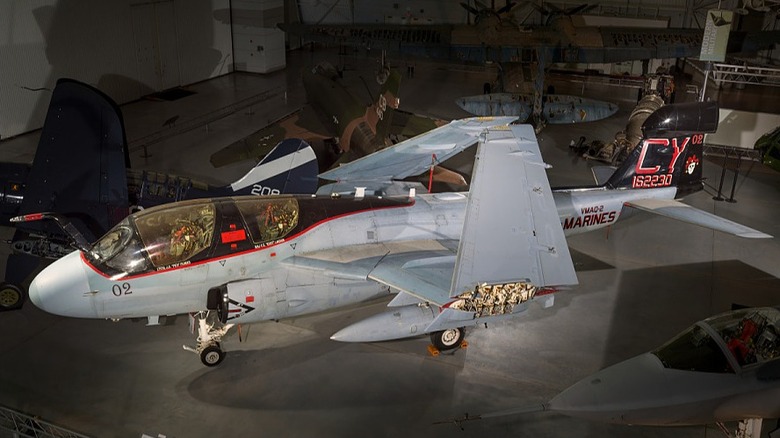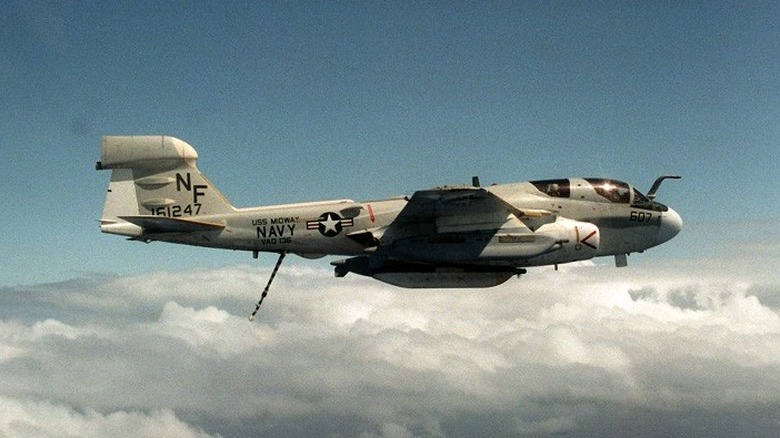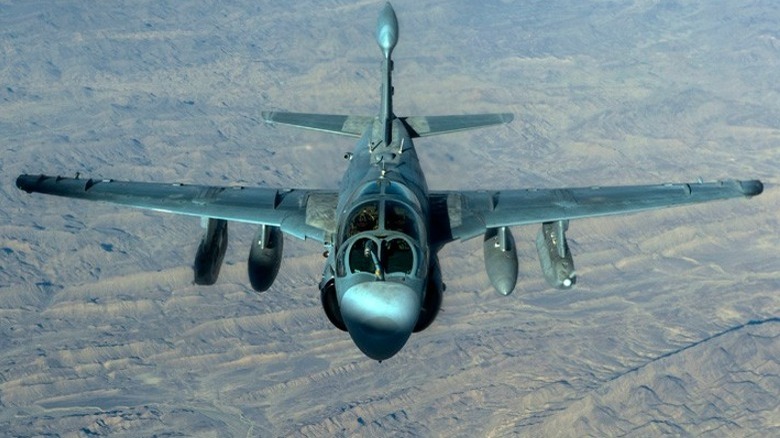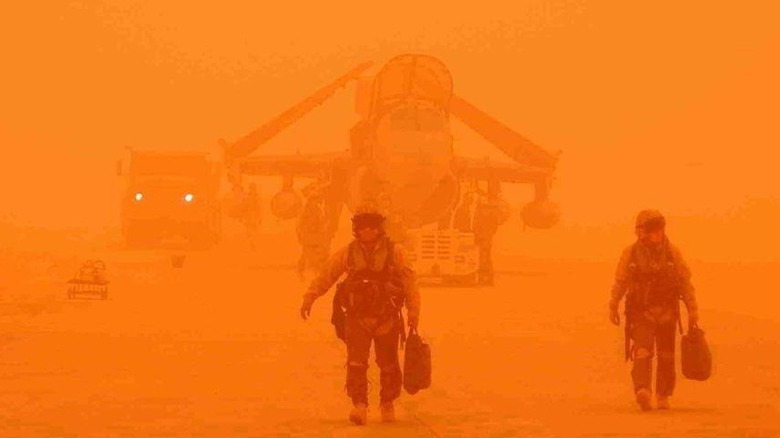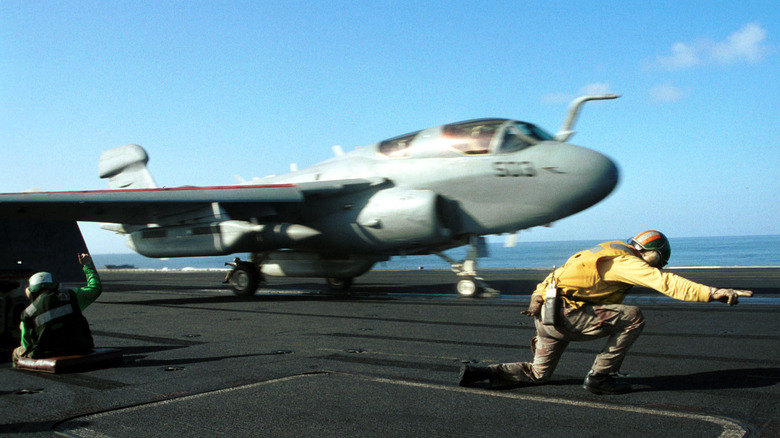EA-6B Prowler: The Electronic Warfare Aircraft That Never Ceased To Impress
American military might is wielded in a wide range of avenues. While gigantic bombers and technologically superior, sixth-generation fighter jets may command the attention of the masses, electronic warfare vessels truly rule the skies. An F-22 pilot might be able to confidently take on any enemy jet that might scramble to meet the challenge of American air superiority, but its counterpart, currently the EA-18G Growler, creates the cover required to decimate threats without breaking a sweat.
Before the Growler was completed, however, the United States military relied on another electronic warfare platform that was equally capable and brilliantly designed: The EA-6B Prowler. Prowlers were a quickly established improvement over the initial EA-6A Intruder, which saw the cockpit expand from a two-member crew to one housing four Marine or Navy fliers (a pilot and three ECMOs responsible for the aircraft's weaponry and countermeasure systems). The first Prowlers were delivered in 1971 and quickly found their way to the battlefront. The EA-6B then remained a prominent fixture of the U.S. military's aerial efforts for the better part of the next five decades. In addition to the vessel's stunning frame and a savage arsenal of electronic and explosive weapons, the service record of the EA-6B Prowler is truly the stuff of legends.
The EA-6B Prowler is an electronic warfare legend
The story of the Prowler begins with its value as an electronic attack aircraft. The airplane was introduced early on in the course of the Vietnam War, and eventually became the U.S. military's "foremost electronic attack platform," according to the U.S. National Naval Aviation Museum.
This aircraft served as the first purpose-built electronic warfare system in the arsenal of the U.S. military. Rather than coming as a reconfiguration of existing technology that could provide a stopgap, the Prowler was intricately constructed to perform this task with precision and ease. A Prowler in active service would have been armed with up to four AGM-88 HARM missiles and as many as five ALQ-99F jamming pods, supported by over 30 individual detection antennae. HARM missiles are anti-radiation weapons that explode over enemy radar systems and devastate the ability to scramble an effective defense. As for purely electronic weaponry, the jamming pods are used to identify enemy communications equipment, radar systems, and other vessels. The Prowler's crew would then utilize the equipment to knock out detection capabilities, communication channels, and guidance systems to render enemy combatants unable to keep pace with American operations in the air and elsewhere.
More recent improvements include a revamp of the cockpit's informational readout, enhanced enemy jamming capabilities, and a boosted threat detection platform for even greater enemy identification abilities. The Prowler system is run on two Pratt & Whitney J52-P-408 turbojets, allowing the aircraft to reach a maximum speed of 610 miles per hour over a 2,400-mile range, and a 38,000-foot altitude ceiling.
The platform has performed surveillance and intelligence gathering tasks as well as direct strikes
In addition to providing cover for ground troops, aerial bombing missions, and other maneuvers, the EA-6B Prowler has also functioned as an intelligence-gathering tool. Crews have been deployed not only to jam communications to support the active engagement of troops on the ground but also as a means to intercept sensitive correspondence between enemy combatants.
Recently, the platform has also flown detection missions that involve identifying IEDs and destroying them without adding civilian casualties or servicemember injuries to the toll that these explosive ambush weapons have taken. Specifically, in Iraq and Afghanistan, Prowlers have utilized their onboard capabilities to identify the radio signals of remotely controlled IEDs and then either jammed the signal to protect mobile ground forces or activated the detonation sequence to dispose of the ordinance safely.
The use of the Prowler in this new context showcases the versatility of the aircraft and highlights the value that the EA-6B has offered the American military for decades.
First used over Vietnam, the Prowler wasn't retired until 2019
The EA-6B Prowler was introduced just in time to augment American forces in Vietnam. The Prowler entered service and was relied on during Operations Linebacker I and II over Vietnam (two strategic bombing campaigns that took place throughout 1972).
In the years since the Vietnam War concluded, the Prowler continued in its support role as a primary escort vessel for bombers, fighter jets, and everything in between. The U.S. military utilized the support of the Prowler's electronic warfare dominance in combat from Grenada and Lebanon to Bosnia and Afghanistan. The EA-6B Prowler flew combat support missions over Iraq during both Operation Desert Storm and more recently against the modern threat of ISIS and others.
The Prowler was such an effective tool for protecting American personnel, positions, and interests across the ground, air, and sea that it remained in service until just a few years ago. The Navy completed the Prowler's retirement in 2015 and the Marine Corps continued flying Prowlers until March 2019.
No Prowlers have ever been lost in combat
Perhaps the most impressive feat across the EA-6B Prowler's 48-year service record is the fact that none were ever lost in combat. Grumman built 170 total Prowler aircraft between 1966 and 1991, and from the time the first Prowler took flight in a combat role, the aircraft remained a crucial tool for ensuring mission success. The Navy assessed the availability of EA-6B accompaniment as a core mission parameter during Operation Desert Storm, for instance. Even with the Prowler seeing heavy action over a wide range of battlefields and theaters of conflict, none were ever shot down.
The legendary EA-6B Prowler is a classic example of reliability and spectacular engineering. Everything about the jet was precision built to ensure that Prowler crews could be deployed whenever necessary and practically guarantee a successful outcome, no matter the mission. Electronic warfare is a relatively new component of battlefield supremacy, in the grand scheme of things, and the Prowler represented the bleeding edge of what this capability might achieve in the future of armed conflict.
